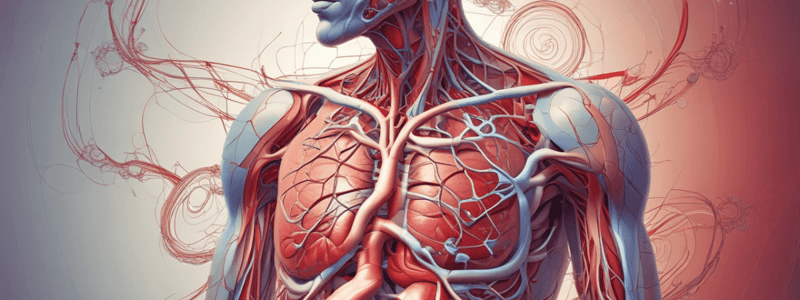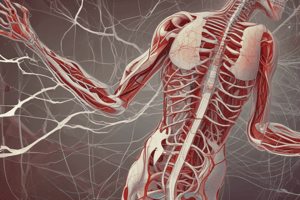Podcast
Questions and Answers
What happens to the local blood flow when the availability of oxygen in the tissues decreases?
What happens to the local blood flow when the availability of oxygen in the tissues decreases?
- It remains unchanged
- It stops immediately
- It increases significantly (correct)
- It decreases slightly
Which of the following is a vasodilatory substance involved in the short-term regulation of local blood flow?
Which of the following is a vasodilatory substance involved in the short-term regulation of local blood flow?
- Epinephrine
- Glucagon
- Insulin
- Adenosine (correct)
What is the result of increased metabolism in a tissue?
What is the result of increased metabolism in a tissue?
- Decreased oxygen utilization (correct)
- Decreased ATP utilization
- Increased oxygen availability
- Increased ATP production
What is the theory that states that blood vessels simply relax in the absence of adequate oxygen, leading to natural dilation?
What is the theory that states that blood vessels simply relax in the absence of adequate oxygen, leading to natural dilation?
What happens to ATP when metabolism increases?
What happens to ATP when metabolism increases?
What is the result of decreased oxygen availability in the tissues?
What is the result of decreased oxygen availability in the tissues?
What is the primary purpose of the local control of blood flow through the tissues?
What is the primary purpose of the local control of blood flow through the tissues?
Which of the following is NOT a function of the local control of blood flow?
Which of the following is NOT a function of the local control of blood flow?
What is the primary mechanism of short-term control of blood flow?
What is the primary mechanism of short-term control of blood flow?
Which of the following is an example of long-term control of blood flow?
Which of the following is an example of long-term control of blood flow?
What determines the amount of blood flow to an organ?
What determines the amount of blood flow to an organ?
What is the term for the minimum amount of blood flow required to meet the tissue's metabolic needs?
What is the term for the minimum amount of blood flow required to meet the tissue's metabolic needs?
What is the primary function of collateral circulation development?
What is the primary function of collateral circulation development?
Which of the following substances is a potent vasoconstrictor that acts on small arterioles?
Which of the following substances is a potent vasoconstrictor that acts on small arterioles?
What is the primary effect of bradicinina on blood vessels?
What is the primary effect of bradicinina on blood vessels?
Which of the following substances is released in response to tissue damage, allergy, or inflammation?
Which of the following substances is released in response to tissue damage, allergy, or inflammation?
What is the consequence of increased oxygen utilization in tissues due to increased metabolism?
What is the consequence of increased oxygen utilization in tissues due to increased metabolism?
What is the most important factor in relaxation of blood vessels?
What is the most important factor in relaxation of blood vessels?
Which of the following substances can produce vasodilation in certain circumstances?
Which of the following substances can produce vasodilation in certain circumstances?
What happens when the pressure is too high according to the metabolic theory?
What happens when the pressure is too high according to the metabolic theory?
What is the result of sudden stretching of small blood vessels according to the myogenic theory?
What is the result of sudden stretching of small blood vessels according to the myogenic theory?
What is the purpose of long-term regulation of blood flow?
What is the purpose of long-term regulation of blood flow?
How does the mechanism of long-term regulation of blood flow work?
How does the mechanism of long-term regulation of blood flow work?
What happens to vascularization when tissue metabolism increases over a prolonged period?
What happens to vascularization when tissue metabolism increases over a prolonged period?
Flashcards are hidden until you start studying



